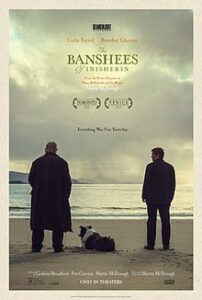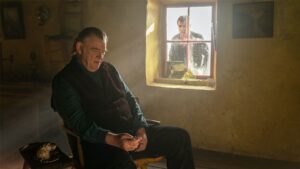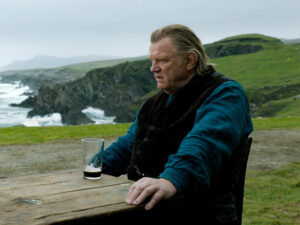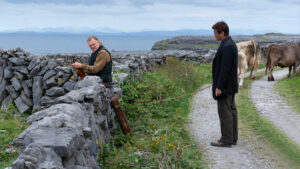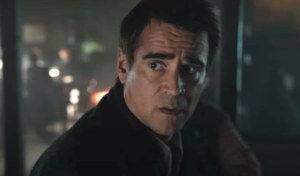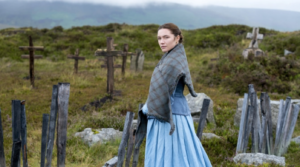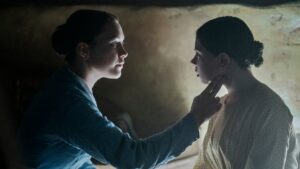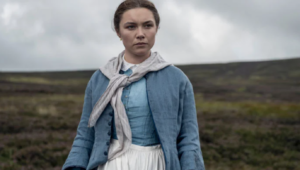A couple of Ireland-shot period movies today, both of which feature old houses burning down. Otherwise, they’re quite different.
The Banshees of Inisherin | Written and Directed by Martin McDonagh | 109 min
I learned today that Inisherin, the island where this yarn is set, is fictional. It was shot in Inishmore, the largest of the Aran Islands off the west coast of Ireland. There’s a lot of reasons to fictionalize a location; I wonder what McDonagh’s was.
This story is set on one side of the island, the smallest portion of a small community. It takes place in 1923 toward the end of the Irish Civil War. The island feels utterly remote, a place of expansive, grey skies and dark, ancient homes of wood and stone.
Colin Farrell is Pádraic, a farmer who lives with his sister, Siobhan (Kerry Condon), a number of cows and a tiny donkey. His lifelong pal down the hill is fiddle player Colm Doherty (Brendan Gleeson), but Colm’s decided he doesn’t want to be Pádraic’s friend anymore. He thinks Pádraic is dull and a distraction from his music. This has a seismic impact on the community — including the wild boy (Barry Keoghan), his father the local cop (Gary Lydon), the bartender at the pub (Pat Shortt), and the witchy old lady (Sheila Flitton).
The raves here at TIFF about this film are almost deafening, and while I liked it about as much as McDonagh’s last picture, Three Billboards Outside Ebbing Missouri, I don’t think it’s a spot on his amazing, riotous In Bruges, the first time Farrell and Gleeson worked with McDonagh on screen. This feels like the film of a distinctly older filmmaker, someone who’s mellowed a little, though full of McDonagh’s trademark dry wit.
You start to wonder whether Pádraic or Colm has it worse off in terms of their shambling mental health as the picture explores the importance of friendship, our relationship to animals, and the constant danger and tragedy of loneliness. It also occurred to me the whole movie could be analogous to the pandemic and the frustrations of a lockdown, though I expect we’ll be looking at every work of art through that lens for some time to come.
The Wonder | Directed by Sebastián Lelio | Written by Lelio and Alice Birch, based on a novel by Emma Donoghue | 103 min
This was an easy sell for me, from the Chilean director of A Fantastic Woman, Gloria, and Disobedience, and the writers of Lady MacBeth and Room, respectively. Given the spectacular talent arrayed this should be exactly what I’m into, but I found The Wonder a bit of a confounding experience. I think that’s because this is a movie about science versus Catholicism, and although it kept my interest overall I don’t think its themes are entirely universal — it might help if you have some personal connection with the Vatican or organized religion plays a role in your life.
Florence Pugh is an English nurse in 1862, Mrs Elizabeth Wright, who’s been “paid handsomely” to go to rural Ireland and spend two weeks to watch over a nine-year-old girl (Kíla Lord Cassidy) who they say hasn’t eaten in four months and yet seems quite healthy. This is shortly after the Irish potato famine, which was largely blamed on the Brits, so Mrs Wright doesn’t get a warm welcome from the locals.
But the first scene is in a warehouse, just outside the ship’s hull set where we meet Pugh’s character. The camera dollies in past rigging and lights into the ship. Why Lelio felt we needed to be reminded in a very specific way of the film’s artificiality, which he comes back to later with a character staring into the camera, I have to assume is to send home the point of a willing suspension of disbelief and how that might relate to religious faith. That’s the best reason I can come up with at short notice.
Wright is rigorously fact-based in her efforts to understand what’s happening with the girl, but also dealing with her own trauma and self-medicates when she’s not hovering over her patient, trying to piece together the mystery of why she’s still alive. The local gaggle of churchy or church-adjacent men, including Ciarán Hinds and Toby Jones, want to sanctify the kid, while local journo, played by Tom Burke, sniffs around Mrs Wright, hoping to uncover the truth through the nurse.
The picture left me with many questions, not the least of which is why Lelio chose a score that sounds like the one from The Bourne Identity spliced with horror-tinged atonal notes. I guess given that mood-setter and the very gloomy exteriors with Pugh marching through the mud I half-expected this to become an all-out supernatural horror rather than a low-key look at religious fundamentalism and the ubiquity of grief. Despite the misdirection I enjoyed the film, especially Pugh’s performance, but it’s a bit of a head-scratcher, for sure.






